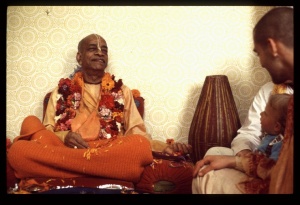CC Madhya 6.141: Difference between revisions
m (1 revision(s)) |
No edit summary |
||
| Line 1: | Line 1: | ||
{{ | [[Category:Sri Caitanya-caritamrta - Madhya-lila Chapter 06|C141]] | ||
<div style="float:left">'''[[Sri Caitanya-caritamrta|Śrī Caitanya-caritāmṛta]] - [[CC Madhya|Madhya-līlā]] - [[CC Madhya 6|Chapter 6: The Liberation of Sārvabhauma Bhaṭṭācārya]]'''</div> | |||
<div style="float:right">[[File:Go-previous.png|link=CC Madhya 6.140|Madhya-līlā 6.140]] '''[[CC Madhya 6.140|Madhya-līlā 6.140]] - [[CC Madhya 6.142|Madhya-līlā 6.142]]''' [[File:Go-next.png|link=CC Madhya 6.142|Madhya-līlā 6.142]]</div> | |||
{{CompareVersions|CC|Madhya 6.141|CC 1975|CC 1996}} | |||
{{RandomImage}} | |||
==== TEXT 141 ==== | ==== TEXT 141 ==== | ||
<div | <div class="verse"> | ||
‘nirviśeṣa’ tāṅre kahe yei śruti-gaṇa | :‘nirviśeṣa’ tāṅre kahe yei śruti-gaṇa | ||
‘prākṛta’ niṣedhi kare ‘aprākṛta’ sthāpana | :‘prākṛta’ niṣedhi kare ‘aprākṛta’ sthāpana | ||
</div> | </div> | ||
| Line 12: | Line 16: | ||
==== SYNONYMS ==== | ==== SYNONYMS ==== | ||
<div | <div class="synonyms"> | ||
''nirviśeṣa''—impersonal; ''tāṅre''—Him; ''kahe''—say; ''yei''—whatever; ''śruti-gaṇa''—the ''Vedas''; ''prākṛta''—mundane; ''niṣedhi''—forbidding; ''kare''—does; ''aprākṛta''—transcendental; ''sthāpana''—confirmation. | |||
</div> | </div> | ||
| Line 19: | Line 23: | ||
==== TRANSLATION ==== | ==== TRANSLATION ==== | ||
<div | <div class="translation"> | ||
“Wherever there is an impersonal description in the Vedas, the Vedas mean to establish that everything belonging to the Supreme Personality of Godhead is transcendental and free of mundane characteristics.” | “Wherever there is an impersonal description in the Vedas, the Vedas mean to establish that everything belonging to the Supreme Personality of Godhead is transcendental and free of mundane characteristics.” | ||
</div> | </div> | ||
| Line 26: | Line 30: | ||
==== PURPORT ==== | ==== PURPORT ==== | ||
<div | <div class="purport"> | ||
There are many impersonal statements about the Supreme Personality of Godhead. As stated in the Śvetāśvatara Upaniṣad (3.19): | There are many impersonal statements about the Supreme Personality of Godhead. As stated in the ''Śvetāśvatara Upaniṣad'' (3.19): | ||
:apāṇi-pādo javano grahītā | :''apāṇi-pādo javano grahītā'' | ||
:paśyaty acakṣuḥ sa śṛṇoty akarṇaḥ | :''paśyaty acakṣuḥ sa śṛṇoty akarṇaḥ'' | ||
:sa vetti vedyaṁ na ca tasyāsti vettā | :''sa vetti vedyaṁ na ca tasyāsti vettā'' | ||
:tam āhur agryaṁ puruṣaṁ mahāntam | :''tam āhur agryaṁ puruṣaṁ mahāntam'' | ||
Although the Supreme Lord is described as having no hands and legs, He nonetheless accepts all sacrificial offerings. He has no eyes, yet He sees everything. He has no ears, yet He hears everything. When it is stated that the Supreme Lord has no hands and legs, one should not think that He is impersonal. Rather, He has no mundane hands or legs like ours. “He has no eyes, yet He sees.” This means that He does not have mundane, limited eyes like ours. Rather, He has such eyes that He can see past, present and future, everywhere, in every corner of the universe and in every corner of the heart of every living entity. Thus the impersonal descriptions in the Vedas intend to deny mundane characteristics in the Supreme Lord. They do not intend to establish the Supreme Lord as impersonal. | Although the Supreme Lord is described as having no hands and legs, He nonetheless accepts all sacrificial offerings. He has no eyes, yet He sees everything. He has no ears, yet He hears everything. When it is stated that the Supreme Lord has no hands and legs, one should not think that He is impersonal. Rather, He has no mundane hands or legs like ours. “He has no eyes, yet He sees.” This means that He does not have ''mundane'', limited eyes like ours. Rather, He has such eyes that He can see past, present and future, everywhere, in every corner of the universe and in every corner of the heart of every living entity. Thus the impersonal descriptions in the ''Vedas'' intend to deny mundane characteristics in the Supreme Lord. They do not intend to establish the Supreme Lord as impersonal. | ||
</div> | </div> | ||
__NOTOC__ | |||
<div style="float:right; clear:both;">[[File:Go-previous.png|link=CC Madhya 6.140|Madhya-līlā 6.140]] '''[[CC Madhya 6.140|Madhya-līlā 6.140]] - [[CC Madhya 6.142|Madhya-līlā 6.142]]''' [[File:Go-next.png|link=CC Madhya 6.142|Madhya-līlā 6.142]]</div> | |||
__NOTOC__ | |||
__NOEDITSECTION__ | |||
Revision as of 10:12, 29 July 2021

A.C. Bhaktivedanta Swami Prabhupada
TEXT 141
- ‘nirviśeṣa’ tāṅre kahe yei śruti-gaṇa
- ‘prākṛta’ niṣedhi kare ‘aprākṛta’ sthāpana
SYNONYMS
nirviśeṣa—impersonal; tāṅre—Him; kahe—say; yei—whatever; śruti-gaṇa—the Vedas; prākṛta—mundane; niṣedhi—forbidding; kare—does; aprākṛta—transcendental; sthāpana—confirmation.
TRANSLATION
“Wherever there is an impersonal description in the Vedas, the Vedas mean to establish that everything belonging to the Supreme Personality of Godhead is transcendental and free of mundane characteristics.”
PURPORT
There are many impersonal statements about the Supreme Personality of Godhead. As stated in the Śvetāśvatara Upaniṣad (3.19):
- apāṇi-pādo javano grahītā
- paśyaty acakṣuḥ sa śṛṇoty akarṇaḥ
- sa vetti vedyaṁ na ca tasyāsti vettā
- tam āhur agryaṁ puruṣaṁ mahāntam
Although the Supreme Lord is described as having no hands and legs, He nonetheless accepts all sacrificial offerings. He has no eyes, yet He sees everything. He has no ears, yet He hears everything. When it is stated that the Supreme Lord has no hands and legs, one should not think that He is impersonal. Rather, He has no mundane hands or legs like ours. “He has no eyes, yet He sees.” This means that He does not have mundane, limited eyes like ours. Rather, He has such eyes that He can see past, present and future, everywhere, in every corner of the universe and in every corner of the heart of every living entity. Thus the impersonal descriptions in the Vedas intend to deny mundane characteristics in the Supreme Lord. They do not intend to establish the Supreme Lord as impersonal.